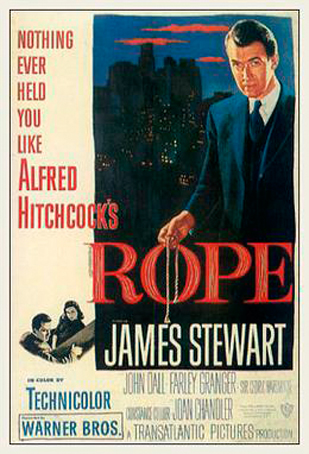SPOTLIGHT
MARCH/APRIL 2021 ISSUE

THE FILMS OF ALFRED HITCHCOCK AND JAMES STEWART
By Douglas Schwartz





All artwork featured in this SPOTLIGHT, whether written or visual, © copyright the respective artists. All rights reserved.
Those who have seen these films know that my brief descriptions don't do them justice. That's because, like all art, each film must be
experienced first hand in order to fully appreciate its artistry. Those who have not seen these films need only know that all four motion
pictures are examples of filmmaking of the highest caliber.
The fact that Alfred Hitchcock and James Stewart are no longer with us makes the films they've created all the more important. Their
collaborations featured in this SPOTLIGHT truly define what classic movies are all about!
experienced first hand in order to fully appreciate its artistry. Those who have not seen these films need only know that all four motion
pictures are examples of filmmaking of the highest caliber.
The fact that Alfred Hitchcock and James Stewart are no longer with us makes the films they've created all the more important. Their
collaborations featured in this SPOTLIGHT truly define what classic movies are all about!
I generally don't believe in saying that one motion picture director or actor is better than another. However, if I were stranded on a
deserted island which somehow managed to have both a television and a DVD player, as well as the electricity to power them, and
I could only watch the films of one director and one primary actor, my choices would be Alfred Hitchcock and James (Jimmy) Stewart.
Limiting the extensive achievements of these two talented artists to only their collaborative efforts, the resulting movie list would include
such notable films as Rope (1948), Rear Window (1954), The Man Who Knew Too Much (1956), and Vertigo (1958). Not a bad roster,
indeed! All are classics in every sense of the word and each one is worthy of watching many times. I certainly have, and I've never
been stranded on a deserted island!
While each film is unique in certain regards, all four are similar in that they each have a connection to murder. For Alfred Hitchcock
fans, this should come as no surprise.
deserted island which somehow managed to have both a television and a DVD player, as well as the electricity to power them, and
I could only watch the films of one director and one primary actor, my choices would be Alfred Hitchcock and James (Jimmy) Stewart.
Limiting the extensive achievements of these two talented artists to only their collaborative efforts, the resulting movie list would include
such notable films as Rope (1948), Rear Window (1954), The Man Who Knew Too Much (1956), and Vertigo (1958). Not a bad roster,
indeed! All are classics in every sense of the word and each one is worthy of watching many times. I certainly have, and I've never
been stranded on a deserted island!
While each film is unique in certain regards, all four are similar in that they each have a connection to murder. For Alfred Hitchcock
fans, this should come as no surprise.


While intelligence is often a good thing,
it can at times be bad to know too much!
Such is the theme behind, what else, The
Man Who Knew Too Much. Set in exotic
locations and involving both murder and
kidnapping, the film takes the audience
on a frantic journey that culminates in not
just one, but two climatic scenes, one of
which includes the memorable clash of
orchestral cymbals.
Hitchcock and Stewart's final collaboration
is, in my opinion, their greatest. Vertigo
is an exquisite example of the power
generated through the marriage of
cinematography (by Robert Burks) and
music (by Bernard Herrmann). Shot at
various locations in and around San
Francisco, Vertigo is, in essence, hypnotic
cinema, which takes hold of the viewer
from the start and does not let go until the
final frame!
it can at times be bad to know too much!
Such is the theme behind, what else, The
Man Who Knew Too Much. Set in exotic
locations and involving both murder and
kidnapping, the film takes the audience
on a frantic journey that culminates in not
just one, but two climatic scenes, one of
which includes the memorable clash of
orchestral cymbals.
Hitchcock and Stewart's final collaboration
is, in my opinion, their greatest. Vertigo
is an exquisite example of the power
generated through the marriage of
cinematography (by Robert Burks) and
music (by Bernard Herrmann). Shot at
various locations in and around San
Francisco, Vertigo is, in essence, hypnotic
cinema, which takes hold of the viewer
from the start and does not let go until the
final frame!
Beginning with their first collaboration,
Rope was shot in a unique cinematic
style that suggests one long camera
shot. Set in a fashionable Manhattan
apartment, Rope has the look and feel
of a theatrical stage play. I don't want
to spoil the film for anyone who's never
seen it. Let's just say that it diabolically
illustrates that it is wise to avoid dinner
parties where the food is served on
a trunk!
Rear Window is about a photojournalist
played by Stewart, who, because of a
broken leg, is confined to a wheelchair
in his small Greenwich Village apartment.
As a result of his boredom, his attention
turns to what's happening in the other
apartments visible outside his rear
window. His seemingly innocent curiosity
eventually turns out to be...shall we say...
dangerous to his health.
Rope was shot in a unique cinematic
style that suggests one long camera
shot. Set in a fashionable Manhattan
apartment, Rope has the look and feel
of a theatrical stage play. I don't want
to spoil the film for anyone who's never
seen it. Let's just say that it diabolically
illustrates that it is wise to avoid dinner
parties where the food is served on
a trunk!
Rear Window is about a photojournalist
played by Stewart, who, because of a
broken leg, is confined to a wheelchair
in his small Greenwich Village apartment.
As a result of his boredom, his attention
turns to what's happening in the other
apartments visible outside his rear
window. His seemingly innocent curiosity
eventually turns out to be...shall we say...
dangerous to his health.

